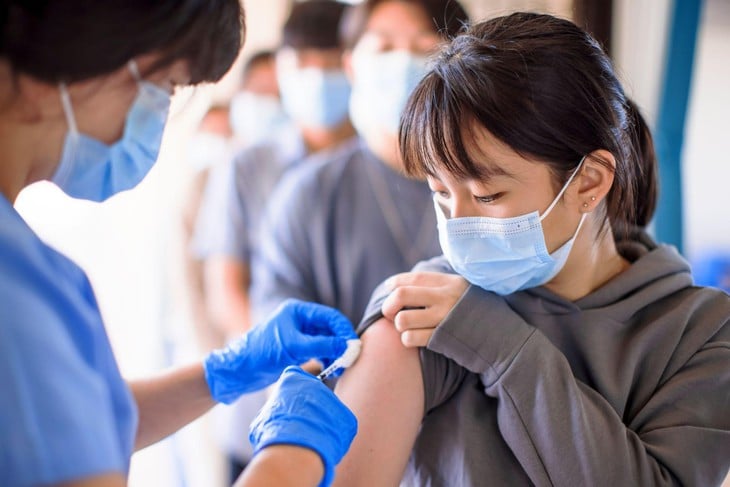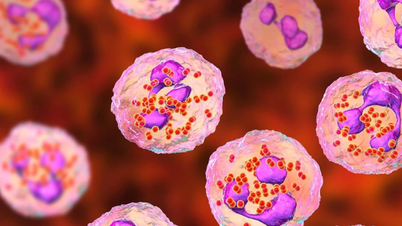Adolescents at high risk for asymptomatic meningococcal disease - Photo: Shutterstock
According to Dr. Nguyen Van Mac Toan, medical manager of Region 1, Central Highlands, VNVC Vaccination System, meningococcal bacteria spread through the respiratory tract through small droplets of saliva or nasal secretions when talking, close contact with the source of the disease including healthy people carrying the bacteria and sick people.
School
Schools are environments with a large concentration of students, where group activities and close living conditions often take place, creating favorable conditions for meningococcal bacteria to spread.
In the US, a study conducted from 2013-2017 at 45 universities showed that there were 80 cases of meningococcal disease caused by serogroups A, B, C, Y, W, and 11 deaths.
An epidemiological study in Suzhou city (China) from 2013-2017 showed that dense classroom density was identified as the main risk factor for bacteria spread.
Schools with students who regularly study in groups and have activities that pose a high risk of spreading meningococcal disease - Photo: Shutterstock
Student dormitories and dormitories
Narrow spaces, shared facilities and eating utensils, and unsanitary conditions can easily create "epidemics" of meningococcal disease in dormitories and collective housing areas.
A study in a university dormitory in Incheon (South Korea) showed that the rate of meningococcal bacteria carriage in students increased from 2.7% at the beginning to 6.3% after 1 month and reached 11.8% after 3 months.
Since the beginning of the year, our country has also recorded two cases of 13 and 17 year old teenagers with severe meningococcal disease, receiving intensive treatment at Thu Duc City Hospital (HCMC) and Bach Mai Hospital ( Hanoi ) respectively.
Close contacts at home and school with patients are being monitored for health.
Meningococcal disease leaves permanent sequelae for adolescents - Photo: Shutterstock
Clubs, bars, pubs
Clubs, bars, and pubs that teenagers often visit lack adequate ventilation and involve close contact, creating conditions for bacteria to spread and making it difficult to control the source of infection.
Parties, bars, pubs, and karaoke are environments where meningococcal disease can spread and is difficult to control - Photo: Shutterstock
Additionally, adolescents tend to engage in intimate contact activities such as hugging, kissing, and sexual intercourse.
This increases the risk of meningococcal infection. According to reports from the Ministry of Health , the Ministry of Education and Training and the World Health Organization (WHO), this contributes to an increased risk of disease.
Festival
Adolescents often participate in recreational activities, socialize, and come into close contact with each other during festivals or events that gather large crowds such as pilgrimages, sporting events, funerals, concerts, etc., increasing the risk of meningococcal infection.
For example, at the 2015 World Scout Council meeting in Japan, attended by more than 33,000 Scouts from 162 countries, six cases of meningococcal group W were reported, and 40 close contacts required prophylactic medication.
Crowded festivals can be difficult-to-control "hotbeds" of meningococcal disease - Photo: Shutterstock
Festival
Meningococcal disease is ranked as one of the top 10 causes of death in Vietnam. About 50% of people with meningococcal disease die if not treated properly.
Even with timely treatment, the disease has a high mortality rate of up to 15%. Up to 20% of patients who survive meningococcal meningitis suffer from many physical and mental sequelae such as amputation, deafness, blindness, mental and behavioral retardation, etc.
Doctor Nguyen Van Mac Toan recommends proactive disease prevention for adolescents as well as family members to repel meningococcal disease.
The common meningococcal serogroups are A, B, C, W, Y, for which there are vaccines in Vietnam, including the American A, C, Y, W-135 vaccine, the Italian B vaccine, and the Cuban B and C vaccines.
Vaccine helps protect teenagers from meningococcal disease - Photo: Shutterstock
A US study on mortality rates by meningococcal serogroup reported between 2017 and 2021 found that group W had the highest mortality rate, at 21.5%, followed by group C (14.6%), group Y (9.8%) and B (9.6%).
Since its introduction, the quadrivalent conjugate vaccine A, C, Y, W-135 has reduced the number of cases of disease in adolescents due to the major serogroups C, Y, and W by up to 90%.
PN
Source: https://tuoitre.vn/5-moi-truong-de-lay-benh-nao-mo-cau-cho-thanh-thieu-nien-2025061717183559.htm








![[Photo] General Secretary To Lam receives President of the Senate of the Czech Republic Milos Vystrcil](/_next/image?url=https%3A%2F%2Fvphoto.vietnam.vn%2Fthumb%2F1200x675%2Fvietnam%2Fresource%2FIMAGE%2F2025%2F11%2F21%2F1763723946294_ndo_br_1-8401-jpg.webp&w=3840&q=75)

![[Photo] Visit Hung Yen to admire the "wooden masterpiece" pagoda in the heart of the Northern Delta](/_next/image?url=https%3A%2F%2Fvphoto.vietnam.vn%2Fthumb%2F1200x675%2Fvietnam%2Fresource%2FIMAGE%2F2025%2F11%2F21%2F1763716446000_a1-bnd-8471-1769-jpg.webp&w=3840&q=75)
![[Photo] President Luong Cuong receives Speaker of the Korean National Assembly Woo Won Shik](/_next/image?url=https%3A%2F%2Fvphoto.vietnam.vn%2Fthumb%2F1200x675%2Fvietnam%2Fresource%2FIMAGE%2F2025%2F11%2F21%2F1763720046458_ndo_br_1-jpg.webp&w=3840&q=75)
![[Photo] National Assembly Chairman Tran Thanh Man holds talks with President of the Senate of the Czech Republic Milos Vystrcil](/_next/image?url=https%3A%2F%2Fvphoto.vietnam.vn%2Fthumb%2F1200x675%2Fvietnam%2Fresource%2FIMAGE%2F2025%2F11%2F21%2F1763715853195_ndo_br_bnd-6440-jpg.webp&w=3840&q=75)








































































































Comment (0)